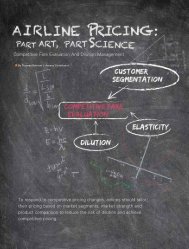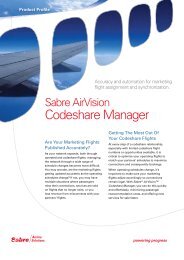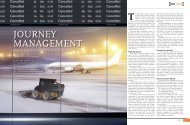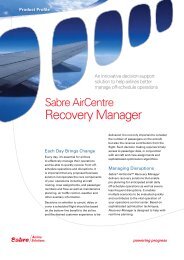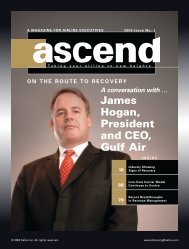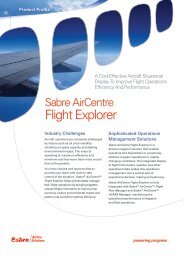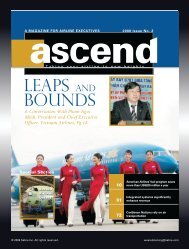2009 Issue 1 - Sabre Airline Solutions
2009 Issue 1 - Sabre Airline Solutions
2009 Issue 1 - Sabre Airline Solutions
You also want an ePaper? Increase the reach of your titles
YUMPU automatically turns print PDFs into web optimized ePapers that Google loves.
From January 2005 until last September,<br />
jet fuel was the single biggest expense<br />
of any airline. It was a larger expense<br />
than maintenance, passenger service and<br />
even the costs of labor. Before 2005, fuel<br />
prices were 10 percent to 15 percent of an<br />
airline’s operating costs. Since January 2005,<br />
fuel prices have fluctuated between 25 percent<br />
and 40 percent of an airline’s operating<br />
costs. Then, in September, the price of jet<br />
fuel began to fall rapidly in line with the cost<br />
of crude oil on the world market.<br />
In mid-July, crude oil reached a peak<br />
of US$147 a barrel for Brent Crude, but just<br />
eight weeks later, oil was selling for less<br />
than US$60 a barrel. In September, the price<br />
of crude oil dropped even further and earlier<br />
this year fell below US$35 a barrel.<br />
Given the significant dip in jet fuel,<br />
airline chief financial officers should be<br />
extremely pleased that their highest single<br />
expense has dropped by about 70 percent,<br />
right? Well, it’s not a simple “yes” because<br />
many airlines had engaged in fuel hedging<br />
and had “bet” on the wrong expectation<br />
that crude oil prices would continue to be<br />
high. When crude oil prices dropped, many<br />
airlines that were highly hedged lost a great<br />
deal of money.<br />
While fuel price was a major driver of<br />
last year’s poor aviation financial performance,<br />
fuel hedges are a major driver of poor aviation<br />
financial performance this year.<br />
The impact of fuel hedging is even more<br />
bizarre than it sounds. If an airline had strong<br />
financial performance and good credit in 2008,<br />
then it engaged in good risk management and<br />
hedged fuel with a strong hedging policy that<br />
protected against the rise of fuel prices. This is<br />
what “good” airline CFOs did to protect their<br />
financial performance.<br />
<strong>Airline</strong>s with poor financial performance<br />
and insufficient credit lines could not afford to<br />
hedge fuel, so they carried a great burden of<br />
risk. The CFOs of these “poor” airlines worried<br />
about the viability of their businesses as<br />
fuel prices skyrocketed because they had little<br />
protection against the unbridled rise of their<br />
largest expense. This was also reflected in the<br />
profit and loss of the airlines and in their share<br />
prices if they were publicly traded.<br />
Strong hedging airlines, such as<br />
Southwest <strong>Airline</strong>s, made millions of dollars<br />
of profit from their hedging positions last year.<br />
Similarly, airlines with strong hedging policies<br />
saw their share prices retain value in a highly<br />
volatile market because their risk management<br />
portfolio was strong. All prudent CFOs who<br />
had available capital or credit facilities invested<br />
in fuel hedges during 2008 for their <strong>2009</strong><br />
and even 2010 fuel requirements, carefully<br />
protecting for the expectation that crude oil<br />
would continue to rise … even above US$200<br />
a barrel.<br />
Much to the happiness of consumers,<br />
the CFOs that hedged against fuel price<br />
increases were wrong. So, the “good” airlines<br />
with strong financial performance and good<br />
credit lines have lost large amounts of money<br />
on their hedges, while the struggling airlines<br />
that were unable to afford fuel hedges have<br />
“won” because fuel prices have dropped by<br />
about 70 percent. The “good” airlines are taking<br />
large reductions in their profits, while the<br />
“poor” airlines are improving their profitability.<br />
This is one of the great reversals in financial<br />
performance in the history of aviation. Since<br />
fuel hedging will have such a large impact on<br />
airline financial performance this year and next,<br />
it is important to understand more about it.<br />
Some CFOs would now call fuel hedging<br />
“gambling” because of their current plight, but<br />
this is not really an accurate definition of the<br />
process. Fuel hedging is a form of risk management<br />
designed to protect against the fear<br />
of volatile fuel prices. When oil is perceived to<br />
be increasing, then fuel hedging becomes an<br />
During the last couple of years, when fuel prices climbed to astronomical levels, fuel accounted for 25 percent to 40 percent of an airline’s<br />
operating expense, up from 10 percent to 15 percent prior to January 2005. those that weren’t in a financial position to leverage fuel-hedging<br />
opportunities suffered tremendously, while others didn’t survive.<br />
ascend<br />
Photo by shutterstock.com<br />
57<br />
special section



